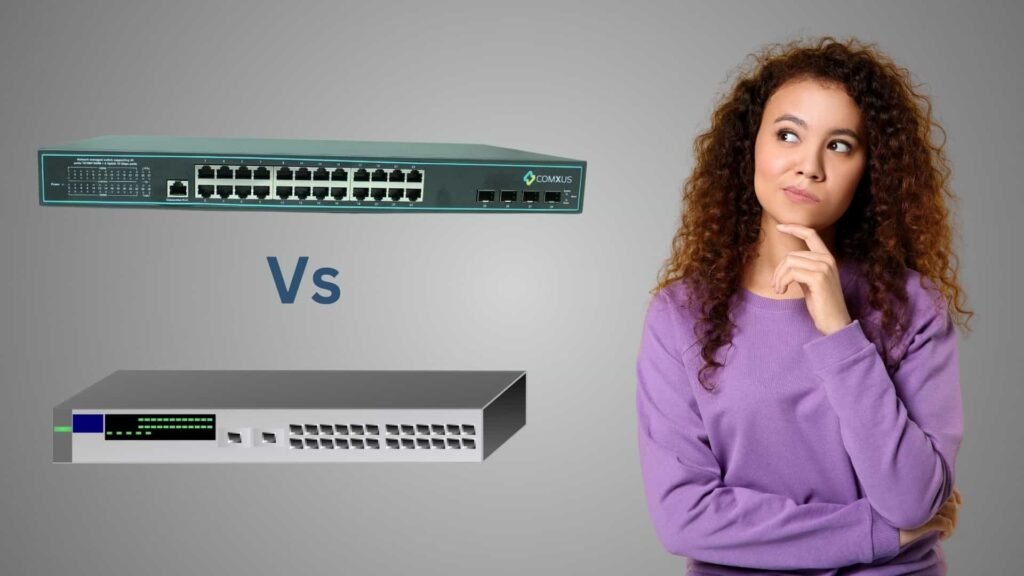Whenever you are going to setup a network, you have to take a very important decision. it is about choosing the right switch between POE and non-PoE. Especially, when you are choosing it for mid or large scaled network.
If you will choose the right switch, it will help you in saving the extra efforts, and money.
If you don’t know the difference between PoE and non PoE switches. do not worry, we are here to help you out.
After reading this article, you will be eligible enough to choose the right industrial managed switch for your industry.

What is a PoE Switch?
A PoE switch allows you to send power & data over the same Ethernet cable. This means you can power devices like IP cameras and VoIP phones without needing a separate power outlet. These switches are also known as power over ethernet switch.
PoE switches make network switches much easier by reducing the number of cables & outlets needed.
What is a Non-PoE Switch?
Meanwhile, a non-PoE switch only transmits data. This type of switch requires separate power sources for any connected devices.
Non-PoE switches are typically simpler and can be a cost-effective choice. it is beneficial for devices that don’t need power through Ethernet. For example- desktop, laptop, printer & Tv etc.
What is the major difference between PoE and Non PoE switch?
If you want to take a look on major advantages of PoE and Non PoE switch.
| Switch | PoE Switch | Non-PoE Switch |
|---|---|---|
| Power Delivery | Provides power through Ethernet cable | No power delivery; separate power needed |
| Installation Flexibility | Allows devices to be placed anywhere | Limited to locations with power outlets |
| Cost | Generally more expensive, but may save on installation | Typically less expensive |
| Power Budget | Has a power budget that limits total output | No power budget; relies on external power sources |
| Device Compatibility | Best for PoE-compatible devices | Works with any Ethernet-enabled device |
| Ideal Use Cases | Security cameras, VoIP phones, and access points | Standard computers, printers, and routers |
| Setup Complexity | Can simplify wiring and reduce clutter | Simpler, but may require more cables and outlets |
- Power Delivery: The most significant difference is how they deliver power. PoE switches provide power to connected devices directly through the Ethernet cable. Non-PoE switches do not provide power, so each device needs its power supply.
- Installation Flexibility: The installation process of PoE switch is much easier. You can place devices like cameras in locations where power outlets are not available. Meanwhile, If you will use the Non-PoE switches limit your options since devices need to be close to power sources.
- Cost: Generally, PoE switches are more expensive than non-PoE switches. However, consider the total cost of your setup. If you need to buy additional power adapters for a non-PoE switch, the costs can add up. In contrast, PoE can save money on installation and wiring.
- Power Budget PoE switches have a power budget, which limits how much power they can supply to devices. Different PoE standards (like PoE, PoE+, and PoE++) offer varying power levels. Non-PoE switches don’t have this limitation since they rely on separate power sources.
- Device Compatibility Not all devices are compatible with PoE. While many modern devices support PoE, some older devices may not. Non-PoE switches can connect any device with an Ethernet port, making them versatile.
When to Choose PoE
If you plan to use multiple devices that require power, such as IP camera or Digital Signage Displays, a PoE switch can be a smart investment.
It simplifies your network setup and can save time and money on installation.
When to Choose Non-PoE
If your network consists mainly of devices that already have their power sources, a non-PoE switch may be the better option.
This choice can reduce initial costs, especially for small setups where only data transmission is needed.
